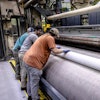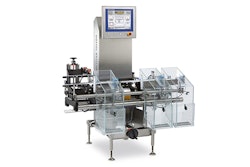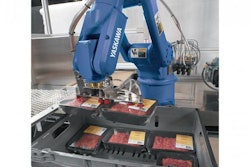The need for safety precautions intensifies as food and beverage supply chains become more advanced and transparent. In an effort to reduce risk in the supply chain, all operational elements are being evaluated. One of these elements is material handling products, such as pallets, used to store, handle and move product. Pallets are essential throughout the entire supply chain and, with the right material, they can help minimize risk of food and beverage contamination before it is too late.
To better understand the importance of compliance in food and beverage supply chains, Food Manufacturing spoke with Ryan Roessler, Plastic Pallet Product Manager at ORBIS Corporation, to discuss the benefits of plastic pallets and risk-reducing material additives.
Q: What categorizes a pallet as risk-reducing?
A: Plastic pallets are risk-reducing because their smooth design makes them free from protruding nails, dust, loose boards and staples that are common with alternative pallets. Also, their one-piece, hygienic design allows for proper sanitation. These are considered major advantages as consumer interest in food and beverage handling grows and new supply chain restrictions reflect modern safety concerns. Recently, The Food Safety Modernization Act (FSMA) caused a re-evaluation of food and beverage handling processes and systems to prevent the production and transportation of contaminated goods.
When the FSMA was implemented in 2011, plastic pallets became a focus of interest for their hygienic characteristics. Hygienic plastic pallets, for example, have a nonporous structure so they cannot absorb moisture, odor or mold, and they don’t have cavities or hollow areas for water to collect. Their one-piece design is easy to wash and dry, so cleaning procedures pose no issue, and their contoured surfaces and corners lower the risk of punctured goods and cases. These plastic pallets also are available in a range of sizes, styles and risk-reducing materials to accommodate most supply chains. Now that FSMA compliance deadlines are fast approaching, companies should strongly consider hygienic plastic pallets — if they haven’t already.
Q: What are the latest breakthrough materials that can help drive supply chain compliance?
A: There is a certain unpredictability with what a unit load interacts with in the supply chain, so pallet material advancements are helping operators protect against risk. Innovative plastic pallets blended with fire-retardant, metal and X-ray detectable, or electrostatic discharge-safe additives are just some of the new materials that have been developed to minimize risk of costly damage to product.
Here are four new plastic pallet materials offered by ORBIS:
- Fire-retardant: These pallets are approved by Factory Mutual Research Corporation in meeting fire rating requirements equivalent to wood pallets. ORBIS recently launched its own fire-retardant plastic material, Proliant, which also is compliant with the Food and Drug Administration.
- Metal detectable: Available in select pallets, metal-detectable additives are blended into the plastic, allowing foreign objects to be detected before making their way into finished goods. This is a feature wood pallets cannot offer.
- X-ray detectable: Similar to metal-detectable additives, products with X-ray detectable material use barium sulfate as a means of detection.
- Electrostatic discharge-safe (ESD): ESD, conductive and antistatic additives provide varying levels of static protection, especially in electronics and chemical applications.
Q: How do these materials improve handling along the supply chain?
A: Plastic pallets manufactured with risk-reducing material additives improve handling in many ways, such as allowing more streamlined and cost-effective safety inspections. They also allow plants to use hygienic plastic pallets throughout their entire internal processing facility. This ensures all operations are secured with food safety precautions. For example, with metal-detectable materials, loads are off-loaded to outbound shipping pallets and sent through metal detectors for inspection. Unlike wood or undetectable plastic, which could not be used during inspection, detectable plastic pallets provide peace of mind that goods are safe to consume and can reduce the risk of recalls related to product damage. Other material additives can minimize static that can slow processes. Food processors believe that preventive measures implemented in the beginning of the supply chain can reduce costly risk before distribution.
Q: What should be considered when choosing a material?
A: There are two main materials used for plastic pallets: polyethylene (PE) and polypropylene (PP) resin. PE has good chemical resistance, impact strength, durability and a temperature range of zero to 120 degrees Fahrenheit. In addition to having all the benefits of PE, PP also offers better flexural modulus, a temperature range of zero to 150 degrees Fahrenheit, and can support heavier, unsupported loads because it deflects less over a long time period. In addition, both plastic materials allow for a longer service life and are compatible with all risk-reducing additives.
Each supply chain is different, so an application analysis is used to determine the appropriate pallet design, material and additive. Load capacity requirements, supported or unsupported racking systems, environment, temperatures and handling equipment are all considered. Because of this, it is recommended that supply chains be designed around the pallet. Knowing the proper pallet upfront guarantees compatibility with plant equipment and procedures. Automation, for example, works best with standardized pallets. Plastic pallets are dimensionally consistent and reduce downtimes associated with other materials. Providers can help with this analysis and engineer appropriate plastic pallet solutions.
Q: Do you have a specific example of risk-reducing pallets improving supply chain safety?
A: As part of their food safety requirements, one of our customers, a Fortune 500 food manufacturing company, requires all inbound ingredients to be moved from wood to plastic pallets in its facility. This is needed because the goods must be brought in on, or moved to, detectable plastic pallets as a food safety initiative, and wood cannot offer the same benefit.
Another customer, a dairy manufacturer, is making the switch to plastic because residue left behind from wood pallets required it to shut down its lines every three days for cleaning, consuming four hours of activity each time. We also put metal-detectable additives in our pallets for agriculture customers so foreign materials can be detected before entering finished goods.






















